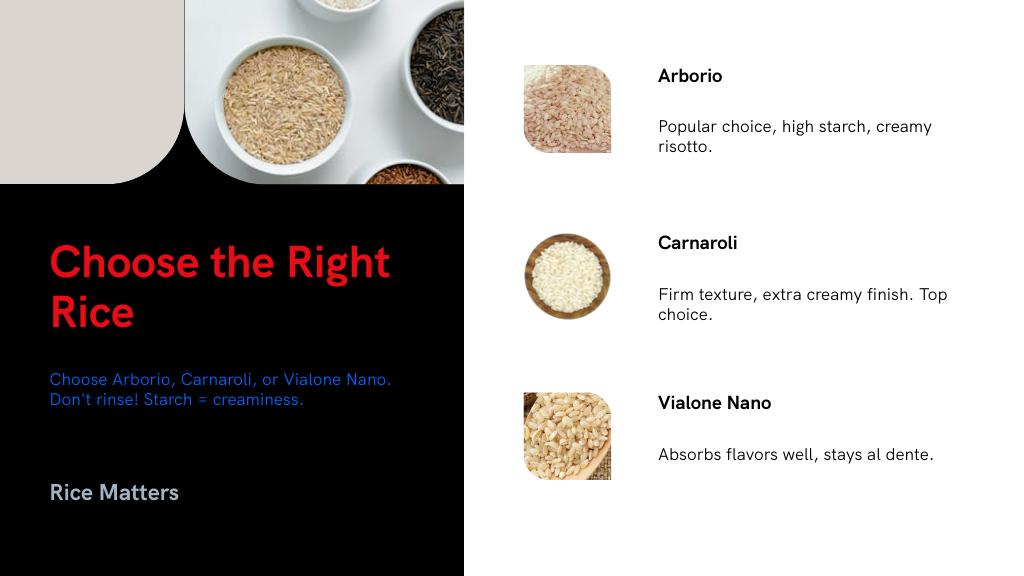
To cook delicious risotto, start by choosing the right rice, like Arborio, and warming low-sodium stock. Sauté finely chopped onions in butter until soft but not browned. Toast the rice briefly, then deglaze with dry white wine. Gradually add warm stock, stirring constantly to release starch and keep a medium simmer. Watch for that creamy, al dente texture. Finish by stirring in cold butter, Parmesan, and fresh herbs. Serve immediately for the best flavor and texture. Keep going to uncover more tips that perfect your risotto every time.
Choose the Right Rice for Creaminess
Choosing the right rice is key to making a creamy risotto. When you ask, how do you cook a risotto that’s perfectly creamy, it starts with selecting the best rice.

Arborio rice is popular because its high starch content creates that signature creaminess. However, Carnaroli rice is often considered the best way to cook risotto for a firmer texture and even creamier finish. Vialone nano is another great option, known for absorbing flavors while staying slightly al dente.
One vital tip: don’t rinse your rice before cooking. Washing away the starch means losing the creaminess you want. Keep the starch intact to get that luscious consistency.
Prepare and Warm Your Stock
To get the best flavor in your risotto, start by choosing a low-sodium chicken or vegetable stock and warming it gently on the stove. Keeping the stock hot is key, since adding cold liquid can slow down cooking and affect the creaminess. You can also infuse your stock with herbs or saffron to add an extra layer of taste before you begin.

Selecting the Right Stock
Although it might seem like a small detail, the stock you use plays an essential role in your risotto's flavor and texture. Always choose a flavorful stock, like low-sodium chicken or vegetable broth, because it directly impacts the dish’s taste.
You’ll need about 4 to 5 cups for a standard recipe, adding it gradually to achieve that perfect creamy consistency. Avoid using cold stock—it can shock the rice and disrupt cooking. Instead, heat your stock gently until it’s steaming, then keep it warm to help the rice release its starch evenly.
To boost flavor, consider infusing your stock with herbs or saffron while it heats. Selecting a well-prepared stock guarantees your risotto will be rich, smooth, and delicious.
Keeping Stock Warm
Since warm stock is key to coaxing out the rice's starch and achieving that perfect creamy texture, you'll want to keep it gently heated throughout cooking.
Heat your chosen stock—ideally low-sodium chicken broth or homemade stock—in a saucepan over low heat. Keep it covered to maintain a consistent temperature, preventing it from cooling down as you gradually add it to the rice.
Adding cold stock would slow the cooking and disrupt the creamy consistency you’re aiming for. Remember to ladle it in small increments, allowing each addition to be fully absorbed before adding more.
Keeping your stock warm guarantees your risotto cooks evenly and stays creamy without sudden temperature drops. This simple step sets the stage for a perfectly luscious risotto every time.
Infusing Stock Flavors
Keeping your stock warm sets a solid foundation, but you can take your risotto’s flavor up a notch by infusing the stock itself. Start by heating 4 cups of low-sodium chicken broth in a saucepan over medium-high heat until it simmers. Then, lower the heat and cover it to keep warm.
To enhance taste, add herbs, spices, or a few saffron threads right into the stock. This gentle infusion lets the flavors meld, adding depth to your risotto. Always use low-sodium or homemade stock—you’ll control seasoning better and get richer flavor.
Remember to keep your stock warm; cold stock slows cooking and affects creaminess. Prepare about 5 cups so you can gradually add it without running out, ensuring perfect texture every time.
Sauté Onions to Sweet Perfection
A key step in making a flavorful risotto is sautéing your onions to sweet perfection. Start by finely chopping one medium white onion, which should give you about 1 ½ cups.
Melt 4 tablespoons of unsalted butter in a large skillet over medium heat, letting it foam but not brown to keep the delicate flavor intact. Add the chopped onions with ½ teaspoon of kosher salt; the salt helps draw out moisture and enhances their natural sweetness as they cook.
Sauté the onions gently for 8 to 10 minutes until they’re soft, translucent, and sweet. Make sure not to let them brown, as caramelizing would change their flavor and could overpower your risotto’s subtle taste.

Toast the Rice to Unlock Flavor
Once your onions are perfectly softened and sweet, it’s time to bring out the best in your rice. Add Arborio, Carnaroli, or Vialone Nano rice to the pan with a bit of butter or oil.
Toast it gently for 1 to 2 minutes, stirring constantly. You’re aiming for a slight translucency around the edges, not browning. This step forms a protective shell on each grain, helping them absorb liquid evenly without becoming soggy.
Toasting also enhances the rice’s flavor and encourages a creamier texture by allowing starches to release gradually during cooking. Make sure you use a wide pan to spread the rice out evenly, preventing sticking or burning. This careful toasting sets the foundation for a perfectly creamy risotto.

Deglaze With Quality White Wine
Nothing elevates risotto quite like deglazing with a quality dry white wine. After toasting the rice, pour in about ½ cup of a good, drinkable white wine—make sure it’s dry, not sweet or too acidic. This step releases the browned bits stuck to the pan, adding depth and richness to your dish.
Stir constantly and let the wine simmer for 3 to 4 minutes until it evaporates, allowing the rice to absorb the liquid fully. This process imparts a subtle acidity that perfectly balances the creaminess of the risotto.

Remember, the wine’s quality matters since it directly influences the flavor. Once the wine is absorbed, you’re ready to move on to adding the warm stock gradually.
Add Warm Stock Gradually and Stir
You’ll want to add warm stock slowly, about half a cup at a time, stirring constantly to let the rice absorb it evenly. Keeping the stock warm and stirring helps release the rice’s starch, creating that creamy texture risotto is known for. Patience here is key—you’ll keep adding stock and stirring until the rice is tender but still has a bit of bite.

Gradual Stock Addition
While cooking risotto, you should add warm stock gradually, about half a cup at a time, to help the rice absorb the liquid evenly and develop a creamy texture. This method guarantees the rice cooks consistently without becoming mushy.
Here’s how to manage your stock addition:
- Keep the stock at a medium simmer to maintain a steady cooking temperature.
- Add the stock slowly, allowing the rice to absorb it before adding more.
- Monitor the risotto’s consistency—it should be creamy and slightly loose before the last addition, as it thickens when resting.
Consistent Stirring Benefits
Adding warm stock gradually is only part of what makes risotto so creamy and flavorful. The real magic happens when you consistently stir the rice while adding the stock in small increments, usually about half a cup at a time. Stirring helps release the starch from each grain, creating the signature creamy texture you want.
It also prevents the rice from sticking to the pan’s bottom and burning, ensuring even cooking. Keep the heat at a medium simmer and stir frequently to let the rice absorb the liquid slowly and evenly, avoiding mushiness.
Maintain the Perfect Simmering Temperature
How exactly do you keep your risotto from turning mushy or unevenly cooked? The key lies in maintaining a perfect simmering temperature. You want a gentle, steady heat—around 180°F to 200°F (82°C to 93°C)—so the rice absorbs the stock gradually without rushing the cooking process.

Here’s how to do it:
- Keep the heat at a medium simmer, not a rolling boil, to avoid uneven cooking.
- Stir occasionally to prevent sticking and help the rice release its starch evenly.
- Adjust the heat if the liquid evaporates too quickly, lowering it slightly to maintain a steady simmer.
Monitor Rice for Ideal Doneness
As you near the end of cooking, keep a close eye on the rice’s texture and appearance to spot when it’s perfectly creamy and al dente. Taste frequently to guarantee the grains are tender but still have a slight bite. If needed, adjust the cooking time or heat to achieve that ideal balance.

Visual Doneness Indicators
When should you know your risotto is perfectly cooked? You’ll want to keep an eye on its appearance and behavior. Here are three key visual doneness indicators to watch for:
- Creamy yet al dente: The rice should look creamy with a slight firmness in the center, offering gentle resistance when bitten.
- Glossy finish and flow: Run a spatula through the risotto—it should hold its shape but slowly flow back together, showing enough released starch for creaminess without stickiness.
- Proper consistency on the plate: When served, the risotto should mound rather than spread out, signaling the ideal richness and creaminess you’re aiming for.
Texture and Taste
Texture plays an essential role in achieving the perfect risotto, so you’ll want to monitor the rice closely as it cooks. Aim for an al dente texture, usually around 18 minutes after adding stock, where the rice is tender but still has a slight bite.
Stir occasionally to prevent a gluey texture and promote even cooking, which helps release starches for that creamy consistency. Watch the rice swell and absorb liquids, tasting as you go to gauge doneness before adding more stock.
Your final risotto should be creamy and luxurious yet hold its shape on the plate, not spread out. Finish off the heat by stirring in cold butter and cheese to boost richness and create a delightful, smooth mouthfeel.
Adjusting Cooking Time
Keeping a close eye on your risotto’s cooking time is key to hitting that perfect al dente balance. Typically, risotto takes 18 to 25 minutes, depending on your rice variety, like Arborio or Carnaroli.
To monitor doneness effectively, follow these steps:
- Stir occasionally to prevent sticking and burning while ensuring even absorption of the stock.
- Taste the rice near the end of cooking; it should be tender but still have a slight bite in the center.
- If it’s too firm, lower the heat slightly and add more warm stock gradually until the desired texture is reached.
Aim for a creamy consistency that's neither too thick nor watery, adjusting cooking time and liquid as needed.
Finish With Butter, Cheese, and Herbs
Although the risotto is cooked, you’re not quite done—stirring in cold butter and freshly grated Parmesan off the heat is key to achieving that rich, creamy texture you’re aiming for. This final step enriches the dish and helps the rice become luxuriously smooth.

Next, fold in fresh herbs like parsley, basil, or chives to add brightness and a pop of color. Be cautious with stronger herbs such as dill or tarragon; use them sparingly so they don’t overwhelm the delicate flavors. Adjust the butter and cheese amounts to suit your taste, but always choose quality ingredients to elevate your risotto.
When plating, aim for a neat mound that showcases the creamy consistency instead of a loose spread—this enhances both appearance and appeal.
Serve Immediately for Best Texture and Taste
Because risotto starts to lose its creamy charm as it cools, you’ll want to serve it immediately after cooking. This guarantees you enjoy its rich texture and full flavor at their peak.

Here’s how to serve it perfectly:
- Serve warm: Risotto tastes best when it’s warm, which brings out its delicate flavors.
- Plate with care: Spoon it into a neat mound on each plate to keep that luxurious, creamy appearance.
- Enjoy right away: If you wait too long, risotto dries out and loses its creamy consistency, making it less enjoyable.
If you need to reheat, stir in a splash of broth to restore moisture. But ideally, dig in right after finishing to savor risotto at its finest.
Conclusion
You might think making risotto is too tricky or time-consuming, but following these 10 essential steps proves otherwise. With the right rice, warmed stock, and careful attention, you’ll create a creamy, flavorful dish that’s well worth the effort. Don’t worry about stirring constantly—it’s more about patience than skill. Give it a try, and you’ll be surprised how easily you can impress yourself and others with this classic Italian comfort food.


















